More than 400 police officers from Ensenada got a chance to get their COVID-19 vaccine, after they were called in …


More than 400 police officers from Ensenada got a chance to get their COVID-19 vaccine, after they were called in …

BY MARTINA DOBESH 10,000 years ago, the first people walked along this coastal area, now known as Baja California. Before …

Mexico’s ARM Cuauhtemoc training vessel will be visiting Ensenada from April 21-24 and again from August 6-9, as part of …

Back in the 1980s, a group in Ensenada came together to try and form something few had seen at the …

The public consultation regarding the acceptance of Sempra’s Energy 2-billion-dollar investment in expanding their current Ensenada plant, is going on …

Fundacion de Amazonas was founded about 6 years ago, and its original goal was to provide shelter and employment opportunities …

Baja is deep into its annual fire season, and as in every year in recent history, brave firefighters are in …

Debra Blake and Carol Woodruff are among the many expats working with the local community to improve the living standards …

Whenever I think of food sold in the Bufadora area, fish tacos, seafood cocktails and churros come to my mind. …

In the course of one’s lifetime, the people who have the most significant and lasting impact on us (besides the …